Titouan Parcollet
CAM
Robust Unsupervised Adaptation of a Speech Recogniser Using Entropy Minimisation and Speaker Codes
Jun 12, 2025Abstract:Speech recognisers usually perform optimally only in a specific environment and need to be adapted to work well in another. For adaptation to a new speaker, there is often too little data for fine-tuning to be robust, and that data is usually unlabelled. This paper proposes a combination of approaches to make adaptation to a single minute of data robust. First, instead of estimating the adaptation parameters with cross-entropy on a single error-prone hypothesis or "pseudo-label", this paper proposes a novel loss function, the conditional entropy over complete hypotheses. Using multiple hypotheses makes adaptation more robust to errors in the initial recognition. Second, a "speaker code" characterises a speaker in a vector short enough that it requires little data to estimate. On a far-field noise-augmented version of Common Voice, the proposed scheme yields a 20% relative improvement in word error rate on one minute of adaptation data, increasing on 10 minutes to 29%.
Evaluation of LLMs in Speech is Often Flawed: Test Set Contamination in Large Language Models for Speech Recognition
May 28, 2025Abstract:Recent work suggests that large language models (LLMs) can improve performance of speech tasks compared to existing systems. To support their claims, results on LibriSpeech and Common Voice are often quoted. However, this work finds that a substantial amount of the LibriSpeech and Common Voice evaluation sets appear in public LLM pretraining corpora. This calls into question the reliability of findings drawn from these two datasets. To measure the impact of contamination, LLMs trained with or without contamination are compared, showing that a contaminated LLM is more likely to generate test sentences it has seen during training. Speech recognisers using contaminated LLMs shows only subtle differences in error rates, but assigns significantly higher probabilities to transcriptions seen during training. Results show that LLM outputs can be biased by tiny amounts of data contamination, highlighting the importance of evaluating LLM-based speech systems with held-out data.
Loquacious Set: 25,000 Hours of Transcribed and Diverse English Speech Recognition Data for Research and Commercial Use
May 27, 2025
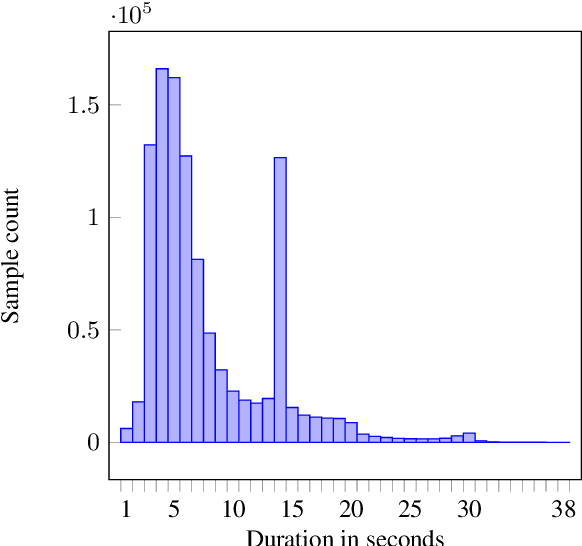
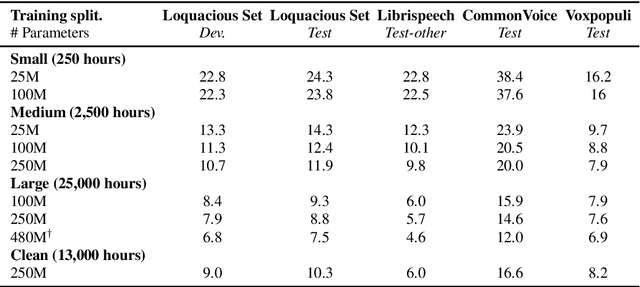
Abstract:Automatic speech recognition (ASR) research is driven by the availability of common datasets between industrial researchers and academics, encouraging comparisons and evaluations. LibriSpeech, despite its long success as an ASR benchmark, is now limited by its size and focus on clean, read speech, leading to near-zero word error rates. More recent datasets, including MOSEL, YODAS, Gigaspeech, OWSM, Libriheavy or People's Speech suffer from major limitations including licenses that researchers in the industry cannot use, unreliable transcriptions, incorrect audio data, or the lack of evaluation sets. This work presents the Loquacious Set, a 25,000-hour curated collection of commercially usable English speech. Featuring hundreds of thousands of speakers with diverse accents and a wide range of speech types (read, spontaneous, talks, clean, noisy), the Loquacious Set is designed to work for academics and researchers in the industry to build ASR systems in real-world scenarios.
Towards Early Prediction of Self-Supervised Speech Model Performance
Jan 10, 2025


Abstract:In Self-Supervised Learning (SSL), pre-training and evaluation are resource intensive. In the speech domain, current indicators of the quality of SSL models during pre-training, such as the loss, do not correlate well with downstream performance. Consequently, it is often difficult to gauge the final downstream performance in a cost efficient manner during pre-training. In this work, we propose unsupervised efficient methods that give insights into the quality of the pre-training of SSL speech models, namely, measuring the cluster quality and rank of the embeddings of the SSL model. Results show that measures of cluster quality and rank correlate better with downstream performance than the pre-training loss with only one hour of unlabeled audio, reducing the need for GPU hours and labeled data in SSL model evaluation.
Benchmarking Rotary Position Embeddings for Automatic Speech Recognition
Jan 10, 2025Abstract:Rotary Position Embedding (RoPE) encodes relative and absolute positional information in Transformer-based models through rotation matrices applied to input vectors within sequences. While RoPE has demonstrated superior performance compared to other positional embedding technologies in natural language processing tasks, its effectiveness in speech processing applications remains understudied. In this work, we conduct a comprehensive evaluation of RoPE across diverse automatic speech recognition (ASR) tasks. Our experimental results demonstrate that for ASR tasks, RoPE consistently achieves lower error rates compared to the currently widely used relative positional embedding. To facilitate further research, we release the implementation and all experimental recipes through the SpeechBrain toolkit.
Linear Time Complexity Conformers with SummaryMixing for Streaming Speech Recognition
Sep 11, 2024Abstract:Automatic speech recognition (ASR) with an encoder equipped with self-attention, whether streaming or non-streaming, takes quadratic time in the length of the speech utterance. This slows down training and decoding, increase their cost, and limit the deployment of the ASR in constrained devices. SummaryMixing is a promising linear-time complexity alternative to self-attention for non-streaming speech recognition that, for the first time, preserves or outperforms the accuracy of self-attention models. Unfortunately, the original definition of SummaryMixing is not suited to streaming speech recognition. Hence, this work extends SummaryMixing to a Conformer Transducer that works in both a streaming and an offline mode. It shows that this new linear-time complexity speech encoder outperforms self-attention in both scenarios while requiring less compute and memory during training and decoding.
An Analysis of Linear Complexity Attention Substitutes with BEST-RQ
Sep 04, 2024
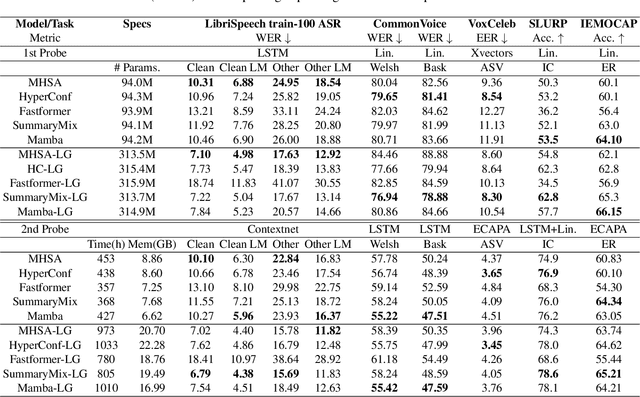
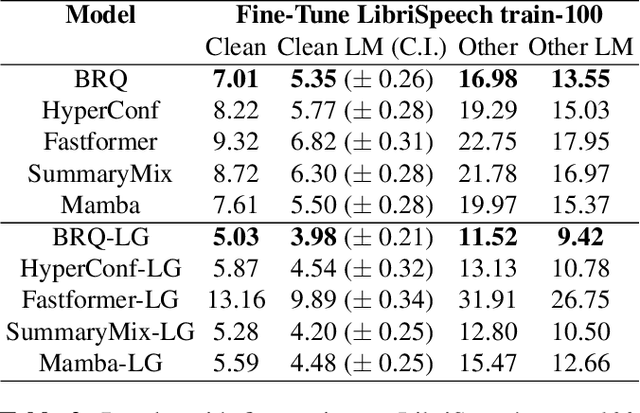
Abstract:Self-Supervised Learning (SSL) has proven to be effective in various domains, including speech processing. However, SSL is computationally and memory expensive. This is in part due the quadratic complexity of multi-head self-attention (MHSA). Alternatives for MHSA have been proposed and used in the speech domain, but have yet to be investigated properly in an SSL setting. In this work, we study the effects of replacing MHSA with recent state-of-the-art alternatives that have linear complexity, namely, HyperMixing, Fastformer, SummaryMixing, and Mamba. We evaluate these methods by looking at the speed, the amount of VRAM consumed, and the performance on the SSL MP3S benchmark. Results show that these linear alternatives maintain competitive performance compared to MHSA while, on average, decreasing VRAM consumption by around 20% to 60% and increasing speed from 7% to 65% for input sequences ranging from 20 to 80 seconds.
Linear-Complexity Self-Supervised Learning for Speech Processing
Jul 18, 2024Abstract:Self-supervised learning (SSL) models usually require weeks of pre-training with dozens of high-end GPUs. These models typically have a multi-headed self-attention (MHSA) context encoder. However, MHSA takes quadratic time and space in the input length, contributing to the high pre-training cost. Linear-complexity alternatives to MHSA have been proposed. For instance, in supervised training, the SummaryMixing model is the first to outperform MHSA across multiple speech processing tasks. However, these cheaper alternatives have not been explored for SSL yet. This paper studies a linear-complexity context encoder for SSL for the first time. With better or equivalent performance for the downstream tasks of the MP3S benchmark, SummaryMixing reduces the pre-training time and peak VRAM of wav2vec 2.0 model by 18% and by 23%, respectively, leading to the pre-training of a 155M wav2vec 2.0 model finished within one week with 4 Tesla A100 GPUs. Code is available at https://github.com/SamsungLabs/SummaryMixing.
Open-Source Conversational AI with SpeechBrain 1.0
Jul 02, 2024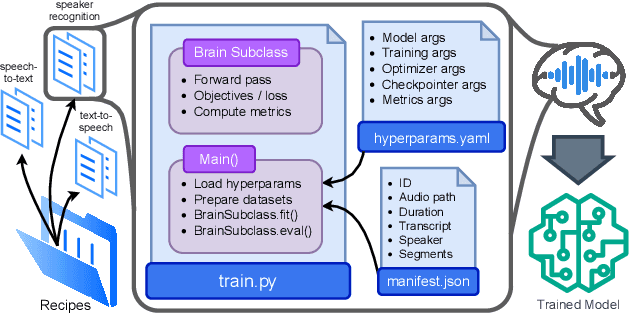

Abstract:SpeechBrain is an open-source Conversational AI toolkit based on PyTorch, focused particularly on speech processing tasks such as speech recognition, speech enhancement, speaker recognition, text-to-speech, and much more. It promotes transparency and replicability by releasing both the pre-trained models and the complete "recipes" of code and algorithms required for training them. This paper presents SpeechBrain 1.0, a significant milestone in the evolution of the toolkit, which now has over 200 recipes for speech, audio, and language processing tasks, and more than 100 models available on Hugging Face. SpeechBrain 1.0 introduces new technologies to support diverse learning modalities, Large Language Model (LLM) integration, and advanced decoding strategies, along with novel models, tasks, and modalities. It also includes a new benchmark repository, offering researchers a unified platform for evaluating models across diverse tasks
Less Forgetting for Better Generalization: Exploring Continual-learning Fine-tuning Methods for Speech Self-supervised Representations
Jun 30, 2024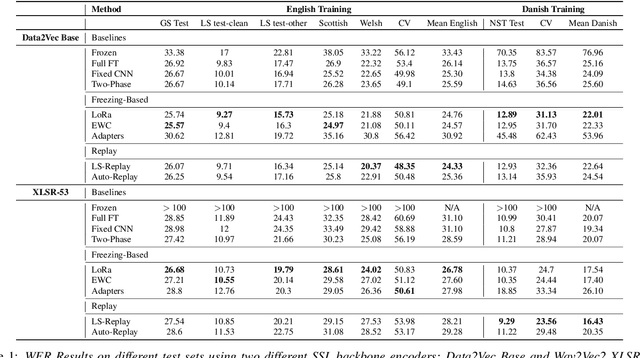

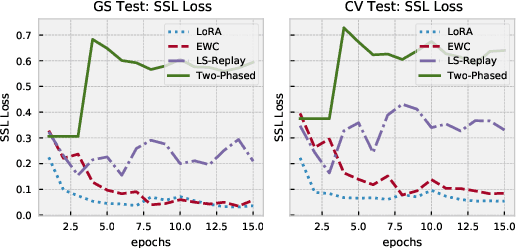
Abstract:Despite being trained on massive and diverse datasets, speech self-supervised encoders are generally used for downstream purposes as mere frozen feature extractors or model initializers before fine-tuning. The former severely limits the exploitation of large encoders, while the latter hurts the robustness acquired during pretraining, especially in low-resource scenarios. This work explores middle-ground solutions, conjecturing that reducing the forgetting of the self-supervised task during the downstream fine-tuning leads to better generalization. To prove this, focusing on speech recognition, we benchmark different continual-learning approaches during fine-tuning and show that they improve both in-domain and out-of-domain generalization abilities. Relative performance gains reach 15.7% and 22.5% with XLSR used as the encoder on two English and Danish speech recognition tasks. Further probing experiments show that these gains are indeed linked to less forgetting.
 Add to Chrome
Add to Chrome Add to Firefox
Add to Firefox Add to Edge
Add to Edge